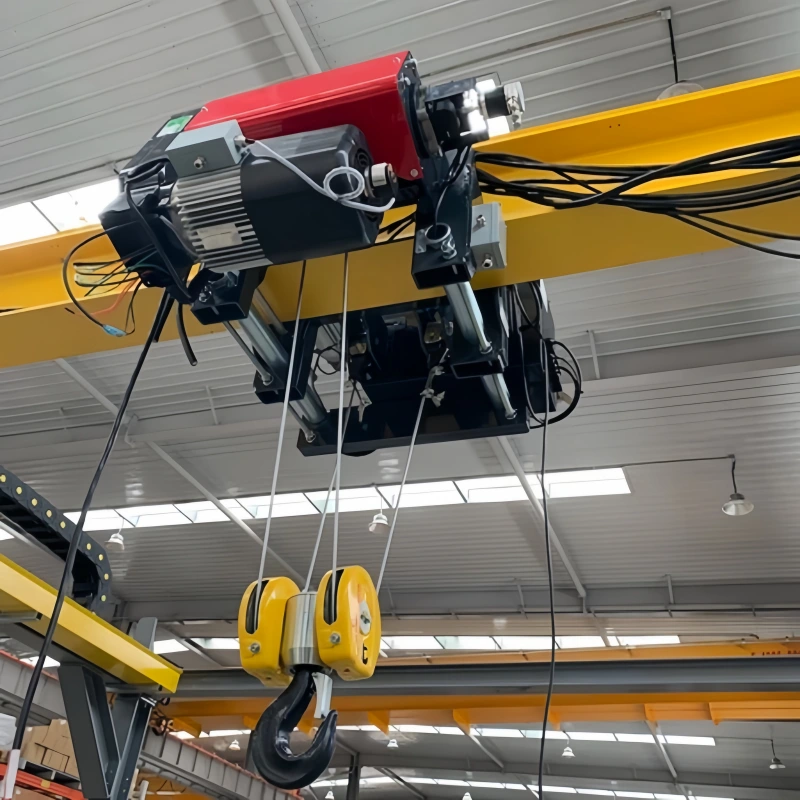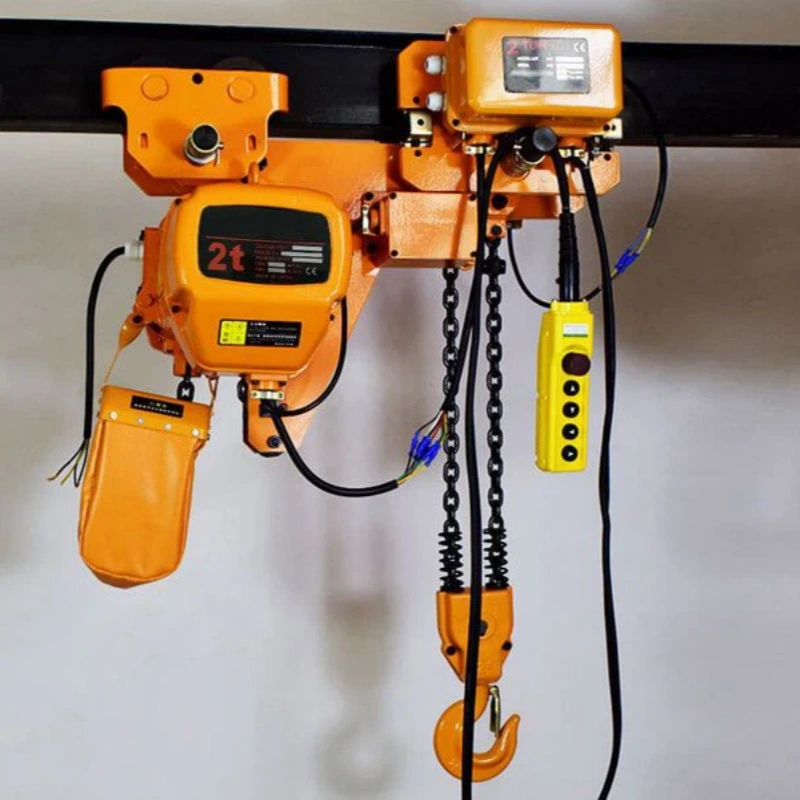Comparing Strengths and Weaknesses
Explore the differences between anchor chains and ropes.
Features | Anchor Chain | Rope |
|---|---|---|
Holding Power | High, thanks to weight and shape | Lower in strong winds |
Shock Absorption | Excellent, reduces stress on the gear | Good, but it can wear on rough seabeds |
Durability | Great resistance to abrasion and corrosion | Prone to UV damage and stretching |
Weight | Heavier maximizes holding power | Lighter, easier to handle |
Cost | Higher upfront cost, longer lifespan | Lower initial cost, needs frequent replacement |
Maintenance | Requires regular inspections for corrosion | Needs checks for fraying and UV damage |
Storage | Bulkier, harder to store | Easier to store and manage |
Flexibility | Rigid, less adaptable | Flexible, adapts to conditions |
When you compare anchor chains vs ropes, you see clear differences in performance and safety. Anchor chains boost holding power with their weight and catenary curve, while ropes offer more elasticity but can struggle in high winds.
Your choice of anchor rode impacts both safety and daily handling. Boat size, anchoring conditions, and budget play a big role in what works best for you.
Choosing the right anchor setup makes a real difference in safety and peace of mind.
Aspect | Anchor Chain Strengths | Rope Weaknesses |
|---|---|---|
Holding Power | High, thanks to weight and shape | Lower in strong winds |
Shock Absorption | Excellent, reduces stress on the gear | Good, but it can wear on rough seabeds |
Durability | Great resistance to abrasion and corrosion | Prone to UV damage and stretching |
Key Takeaways
Anchor chains provide superior holding power and durability, making them ideal for rough conditions and rocky seabeds.
Anchor ropes are lighter and easier to handle, offering excellent shock absorption, which is beneficial for smaller boats or calm waters.
Choose your anchor rode based on your boat size and anchoring environment; combining chain and rope can balance strength and ease of use.
Regularly inspect your anchor rode for wear and damage to ensure safety and reliability during your boating trips.
Use a proper scope ratio when anchoring; aim for a minimum of 5:1 in calm weather and increase to 7:1 or more in strong winds.
Anchor Chain vs Rope
What Is an Anchor Chain?
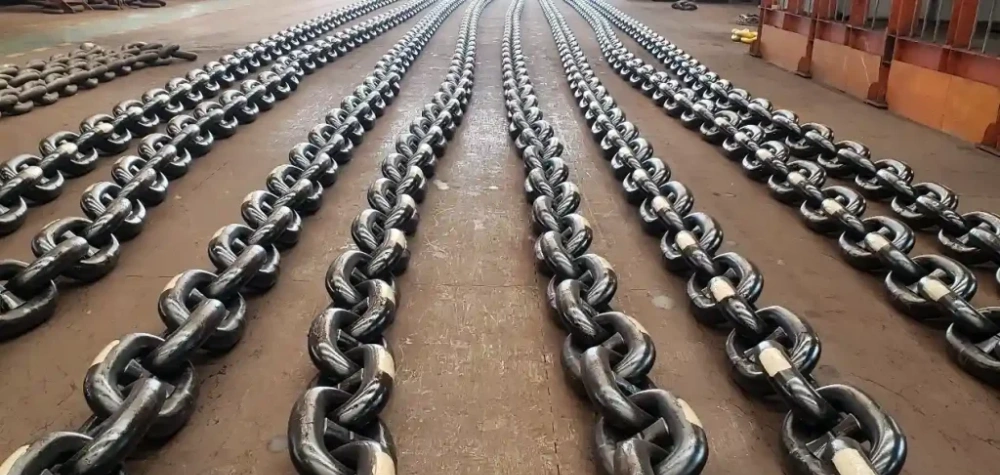
You use an anchor chain as a heavy, durable link between your anchor and your boat. Anchor chains come in different types, such as stud link and studless, each designed for specific marine tasks.
The weight of the chain helps your anchor set more effectively by keeping the pull on the anchor as horizontal as possible. This horizontal force increases holding power, especially in rough conditions. Anchor chains resist abrasion from rocks and debris, making them ideal for challenging seabeds.
What Is an Anchor Rope?
An anchor rope, often called an anchor line or rode, connects your anchor to your boat using strong, flexible material—usually nylon. Ropes are lighter and easier to handle than chains.
They provide excellent shock absorption, which protects your boat and gear from sudden jerks caused by waves or wind. You can store rope more easily, and it works well for smaller boats or when weight is a concern.
When to Use Each?
Choosing between an anchor chain and vs rope depends on your boat size, anchoring location, and expected conditions. Anchor chain vs rope becomes a key decision when you consider water depth, bottom type, and weather.
For example, anchor chains perform best in rocky or abrasive bottoms and when you need maximum holding power. Ropes excel in calm, shallow waters or when you need to reduce weight.
Tip: Always match your anchor rode to your boating environment for the safest results.
Here’s how anchoring conditions affect your choice:
Factor | Anchor Chain vs Rope Considerations |
|---|---|
Water depth | Anchor chain vs rope: Chain offers better scope in deep water; rope is easier to handle in shallow areas. |
Bottom composition | Anchor chain vs rope: Chain resists abrasion on rocks; rope works well in sand or mud. |
Holding power and scope | Anchor chain vs rope: Chain maintains horizontal pull for better holding; rope may need more scope. |
When you compare anchor chain vs rope, you see that each has strengths for specific situations. Anchor chains give you durability and holding power, while ropes offer flexibility and ease of use.
Anchor Chain vs Rope: Pros and Cons
Strength and Durability
When you compare anchor chain and rope, you notice clear differences in strength and durability. Anchor chain stands out for its ability to resist abrasion and chafing, especially on rocky or aggressive sea beds. The metal links prevent wear from sharp objects and constant movement.
You can rely on the anchor chain to provide a horizontal pull on the anchor, which helps it set firmly even in light winds. This horizontal force also improves holding power in moderate conditions.
Anchor rope, usually made from nylon, offers good strength but does not match the abrasion resistance of chain. Over time, rope can fray, especially if it rubs against rough surfaces. You might find that rope lasts between 8 and 15 years, while anchor chain often serves for 10 to 20 years.
Some boaters have used the same anchor chain for over two decades, even with visible rust, while others replace the rope after 15 years due to fraying.
Here’s a quick look at breaking strengths for both materials:
Material | Size | Average Break Strength |
|---|---|---|
Premium Three Strand Rope | 1/2″ | 7,500 lb. |
Proof Coil Chain | 1/2″ | 18,000 lb. |
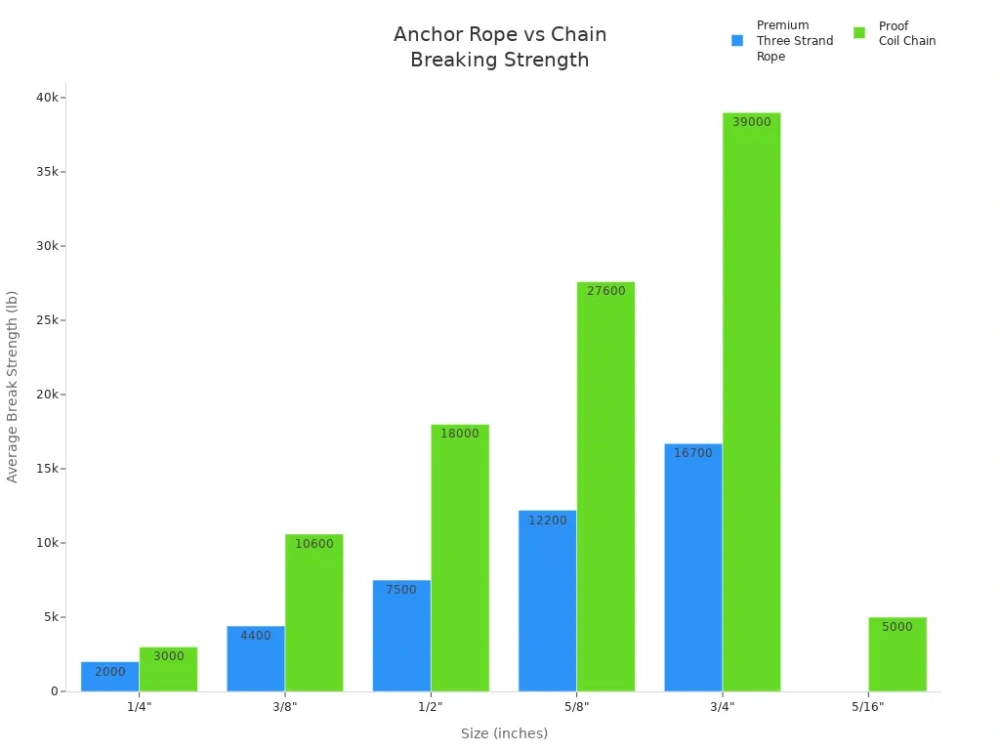
Tip: If you anchor in areas with rocks or debris, a chain gives you better long-term durability and protection.
Weight and Handling
Weight plays a major role in how you handle your anchor system. An anchor chain adds significant weight to the bow of your boat. This extra weight helps the chain lie flat on the seabed, which increases holding power and reduces the risk of dragging.
However, you may find it more difficult to haul up, especially if you anchor in deep water or have a small crew.
Anchor rope, on the other hand, is much lighter and easier to manage. You can deploy and retrieve rope quickly, making it a popular choice for smaller boats or solo boaters. Rope does not weigh down the bow, so it keeps your boat balanced and easier to maneuver.
However, in rough conditions, the rope may not provide enough weight to keep the anchor rode flat, which can reduce holding power.
Anchor chain: Heavier, lies flat, maximizes holding power, but harder to handle.
Anchor rope: Lighter, easy to handle, but may not hold as well in strong winds.
Note: Many boaters use a combination of chain and rope to balance ease of handling with reliable holding power.
Cost and Maintenance
Cost and maintenance also influence your decision between anchor chain and rope. Anchor chain usually costs more upfront, but it offer a longer lifespan and greater durability.
You need to inspect your anchor chain regularly for signs of corrosion or wear, especially after severe weather. Most experts recommend pre-trip checks, monthly inspections, and thorough seasonal reviews to catch any issues early.
Anchor rope costs less initially, but you may need to replace it more often due to fraying or UV damage. Rope requires regular inspection for cuts, abrasion, and signs of weakening. You should check your rope before each outing and after any rough conditions.
Inspection Type | Frequency | Purpose |
|---|---|---|
Pre-Trip Inspections | Before each outing | Prevent unexpected failures on the water. |
Monthly Inspections | At least once a month | Conduct thorough checks of the entire anchor system. |
Seasonal/Annual Inspections | Beginning and end of season | Comprehensive checks for wear and corrosion. |
After Severe Conditions | Immediately after exposure | Inspect for damage after severe weather or rough seas. |
Regular maintenance extends the life of both anchor chain and rope, saving you money and reducing the risk of failure.
Anchor Rode Performance
Holding Power
When you anchor your boat, holding power becomes the most important factor for safety. Anchor chain delivers superior holding power in strong currents and rough weather. The weight of the chain helps keep the anchor firmly dug into the seabed.
The catenary effect, created by the curve of the chain, acts as a shock absorber and prevents sudden jerks that could dislodge the anchor. In challenging conditions, an all-chain rode offers maximum strength and resistance to abrasion.
Rope, while strong, relies more on scope and elasticity to maintain holding power. You may need to let out more rope to achieve the same security as a chain, especially in deep water or shifting winds.
Tip: For maximum holding power, use at least one boat length of chain before attaching the rope.
Shock Absorption
Shock absorption protects your boat and anchor system from sudden loads caused by waves or wind gusts. Rope excels in this area due to its natural elasticity. When you use nylon rope, it stretches and absorbs shocks, making it ideal for smaller vessels or variable weather.
The chain manages shock loads through its weight and the catenary curve, which dampens sharp pulls. Many experienced sailors recommend adding a nylon snubber to an all-chain rode. This combination gives you the shock absorption of rope with the durability of chain.
Rope: Absorbs shocks with stretch, ideal for rough weather.
Chain: Dampens shocks with weight and curve, best when paired with a snubber.
Chafe Resistance
Chafe resistance determines how well your anchor rode withstands abrasion from rocks, coral, or debris. Anchor chain resists chafe better than rope, especially on rocky seabeds. The metal links protect against wear and damage.
However, the connection point between the chain and the rope can become vulnerable if it rubs against hard surfaces. Nylon rope offers good elasticity and shock absorption, but it can suffer from chafe if it gets tangled with rocks or sharp objects.
To maximize chafe resistance, always use a length of chain before the rope and inspect connection points regularly.
Rode Type | Best Use Case | Chafe Resistance |
|---|---|---|
All Chain | Rocky, abrasive bottoms | Excellent |
Chain + Rope | Mixed conditions | Good (with inspection) |
All Rope | Sand, mud, calm waters | Moderate |
Anchor Rode Length
Calculating Length
You need to determine the right length of anchor rode for your boat to ensure safety and reliable holding. The most common method uses a scope ratio, which compares the length of the rod to the depth of the water. For calm weather, a minimum scope of 5:1 works well.
This means if you anchor in 10 feet of water, you should let out 50 feet of rode. In stronger winds or currents, increase the scope to 7:1 or even 10:1. The total rode should be four to seven times the water depth.
For vessels under 50 feet in storm conditions, many experts suggest using a combination of 20% chain and 80% nylon rode with a scope of 6:1.
Minimum scope for calm weather: 5:1
In windy conditions: 7:1 or 10:1
For every 10 feet of depth, deploy 50 to 100 feet of rode, depending on conditions
Tip: Always measure the water depth from the bow, not the waterline, to get an accurate rode length.
Rules of Thumb
You can follow several widely accepted rules of thumb to simplify your anchor rode calculations. These guidelines help you adapt to different anchoring conditions and boat sizes.
Condition | Recommended Scope |
|---|---|
Calm conditions | 3 times the water depth |
Moderate winds | 5 times the water depth |
Strong winds or a storm | 7 times the water depth or more |
Fixed length plus depth | 15 meters + 2 times the depth |
Wind speed multiplier | Depth x expected wind speed |
Minimum chain length | 3 to 6 times the boat’s length |
Adjusting for Conditions
You must adjust your anchor rode length as weather and tidal conditions change. A general rule is to use a 7:1 ratio of rode to water depth. For example, anchoring in 10 feet of water requires at least 70 feet of rode. In tidal areas, increase the scope to ensure the anchor remains secure during high tide.
When the tide rises, let out more rode to maintain the proper ratio. If the tide falls, retrieve some rode to prevent excessive slack. Always monitor the swing radius of your boat, which can change with wind and tide, to avoid collisions. In strong currents, consider deploying a second anchor for added stability.
Note: Attach an elastic bungee to your anchoring rope to absorb wind gusts and swells, which helps prevent anchor dislocation.
Best Rope Types for Anchor Chains
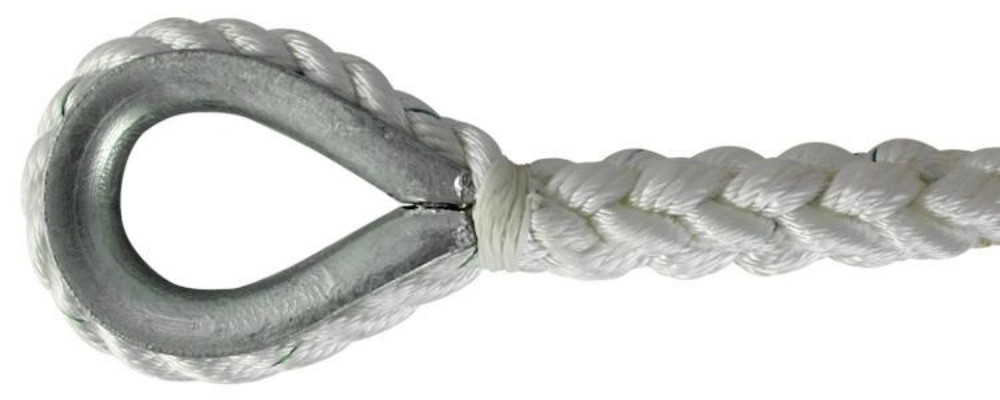
Nylon Rope
Nylon rope stands out as the most popular choice for pairing with high-quality anchor chains. You benefit from its unique combination of strength, flexibility, and shock absorption. Nylon’s elasticity helps absorb sudden loads from waves or wind, which protects your boat and anchor system.
This rope type also sinks, making it ideal for anchoring because it stays below the water’s surface and reduces the risk of tangling with other gear.
Nylon is light and easy to handle.
It offers excellent stretch, which cushions your boat during rough conditions.
You can find nylon rope in both 3-strand and 8-strand constructions, both of which splice well to anchor chain.
Tip: Always use a professional splice when connecting nylon rope to your anchor chain for maximum security.
Other Rope Materials
While nylon is common, you may consider polyester rope for certain situations. Polyester provides less stretch than nylon, which can help reduce boat movement in longer anchor rodes.
It also offers superior chafe resistance and better UV stability. If you anchor in areas with sharp rocks or strong sunlight, polyester can last longer and maintain its strength.
Rope Type | Stretch | Chafe Resistance | UV Resistance | Best Use Case |
|---|---|---|---|---|
Nylon | High | Good | Moderate | General anchoring, shock loads |
Polyester | Low | Excellent | High | Rocky bottoms, high UV areas |
Polyester and nylon both splice easily to chain, so you can choose based on your anchoring needs.
Choosing Diameter
Selecting the right diameter ensures your anchor rode matches your boat size and expected conditions. For smaller boats, an oversized nylon rope makes handling easier and increases durability. For longer anchor ropes—over 150 feet—less stretchy materials like polyester may help prevent excessive movement.
Always check the working load limit (WLL) for your chosen rope, especially if you anchor in severe weather. A thicker rope increases strength but may be harder to handle and store.
Note: Match your rope diameter to your boat’s displacement and anchoring environment for the safest results.
Connecting Rope and Chain
Splicing Methods
You have two main options when connecting rope to chain: splicing and hardware connectors. Splicing techniques, such as the 2-strand and 3-strand rope-to-chain splice, create a seamless transition between rope and chain.
This method maintains nearly all of the rope’s original breaking strength, which means you maximize reliable holding power. Splicing also reduces snags and wear, making it the preferred choice for long-term durability.
If you want to secure your boat with confidence, follow instructions from trusted resources like “The Ashley Book of Knots” or “The Rigger’s Apprentice.” Eye splice and back splice methods work well for most anchor setups.
Tip: Splicing creates a smooth connection that passes easily through windlasses and fairleads, minimizing wear and tear.
Method | Description | Notes |
|---|---|---|
2-Strand Splice | Joins rope directly to the chain using two strands | Best for smaller boats |
3-Strand Splice | Uses three strands for a stronger, more secure connection | Ideal for larger vessels and heavy-duty anchoring |
Shackles and Connectors
If you prefer hardware, shackles and swivels offer a practical alternative. Bow shackles allow more articulation, which helps handle awkward forces from wind shifts or tidal changes. D shackles fit narrower spaces and provide strong, in-line connections.
Snap shackles work for quick-release situations, but they do not suit heavy loads. For the strongest joint, couple shackles back to back and use the largest diameter pin available. Swivels, such as the Ultra Flip Swivel, prevent lateral loading and anchor twisting during deployment.
Shackle Type | Description | Use Case |
|---|---|---|
Anchor/Bow Shackle | Handles loads from multiple directions | Securing anchors and holding lines |
Chain/D-Shackle | Designed for high loads in line | Connecting the chain to the anchor rope |
Snap Shackle | Quick-release, not for heavy loads | Fast connections |
A couple of shackles for strength.
Use bow shackles for freedom of movement.
Choose D shackles for tight spaces.
Safety Tips
You must prioritize safety when connecting rope and chain. Ensure correct alignment of load-bearing surfaces to distribute force evenly and avoid pinpoint loads. Provide articulation in the connection to handle shifting forces from wind or tide.
Always use components rated with a manufacturer-minimum break load to prevent weak links in your anchor rode. The rope’s tensile strength should be at least eight times the expected load. Consider adding a swivel if you deploy the anchor for extended periods or use multiple anchors.
Note: Regularly inspect all connections for signs of wear, corrosion, or misalignment to maintain reliable holding power and secure your boat in any conditions.
Conclusion
You should match your anchor rode to your boat and environment. Larger vessels or rocky bottoms benefit from all-chain setups, while lighter boats or sensitive areas favor rope. Consider your budget, as robust systems cost more in challenging conditions. Many boaters combine chain and rope for versatility.
For best results, use a high-quality anchor suited to your seabed, pair it with a tested splice, and always include a chain section for improved holding power.
Rode Type | Best For | Key Benefit |
|---|---|---|
All Chain | Heavy boats, rough seas | Maximum durability |
Rope + Chain | Mixed conditions | Flexibility & safety |
All Rope | Calm, shallow waters | Easy handling |
FAQ
What is the main difference between an all-chain anchor rode and a rope rode?
An all-chain anchor rode provides maximum durability and holding power, especially in rough anchoring situations. A rope ride offers easier handling and better shock absorption. You should choose based on your boat size, anchoring situation, and the seabed you expect to encounter.
Can I combine a chain and rope in my anchor rode?
Yes, you can combine a chain and a rope in your anchor rode. This setup gives you the abrasion resistance of a chain and the flexibility of rope. Many boaters use this combination for mixed anchoring situations, balancing strength, weight, and ease of use.
How do I decide the right length for my anchor rode?
You should base the length of your anchor rode on water depth and expected conditions. For most anchoring situations, use a scope of 5:1 in calm weather and 7:1 or more in strong winds. Adjust your rode length as conditions change.
Which anchor rode is best for rocky or abrasive bottoms?
An all-chain anchor rode works best for rocky or abrasive bottoms. The chain resists chafe and keeps the anchor secure. If you use a rope rode, always add a chain section to protect against abrasion in these anchoring situations.
How often should I inspect my anchor rode?
Inspect your anchor rode before each trip and after any severe weather. Check for signs of wear, corrosion, or chafe. Regular inspections help you avoid failures and keep your anchor rode reliable in every anchoring situation.

